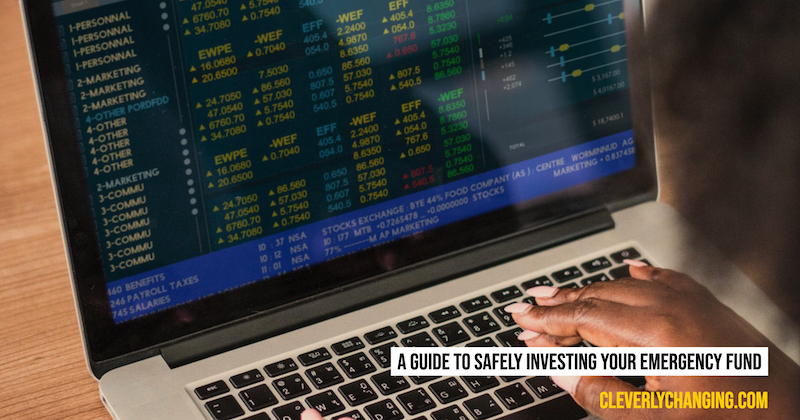Do a quick search for top pieces of financial advice, and you’ll inevitably come across several variations of what ultimately amounts to ‘build an emergency fund.’ What’s less talked about, however, and almost never follows said advice on personal finance blogs, is where to put that emergency fund.
Should it be under a mattress, in a savings account, or a prepaid debit card? None of these are especially great options. Why? The three key things in an emergency fund saving strategy are liquidity, safety, and ability to generate a return (after all, just because an emergency fund is there to get you through a tight spot doesn’t mean you shouldn’t be trying to add to it).
Any place that you consider putting your emergency fund should tick all these boxes. Let’s discuss a few smart strategies that fit the criteria.

High-Yield Savings Account
Nothing is exciting about savings accounts. The average annual percentage yield (APY) of savings accounts was just .06 percent in 2013 per CNNMoney. Large brick-and-mortar banks usually are the culprits behind these uselessly low interest rates. Conveniently, though, plenty of online-only banks offer APYs ranging from 1.85–2 percent — some don’t even require minimum balances!
Be advised that these rates aren’t fixed. The banks can change them at any time (and they will). If you sign up for a bank at 2.05 percent, don’t be surprised to see it scale down to 1.85 eventually. However, with the simplicity of online sign-up, it’s hard to argue against adding monthly interest to your emergency fund for doing nothing.
High-yield savings accounts are also highly liquid, offering free monthly withdrawals and ATM access. The top offers are always changing; here’s a look at December’s best online savings accounts roundup. Even if you haven’t reached your emergency fund goal, it’s still a good time to open a high-yield savings account so you can earn interest on what you do have (and every deposit you make) in the meantime.
CD Ladder
A certificate of deposit is a straightforward and safe way to earn a modest return on investment. The downside for such a foolproof strategy is that it ties up your money for a specified amount of time. For example, a 3-year CD could generate 3.35 percent APY, but a substantial investment amount is required to get a significant return—and three years is a long time not to have access to funds. But like financial entrepreneur Andrew Housser cites as his most successful weapon, setting incremental goals creates accountability and leads to real results. The same is true when we commit to an investment plan with CDs—aka a CD ladder.
Investing in a CD ladder strategy with an emergency fund makes a lot of sense — both as a way to grow and keep funds. A CD ladder involves buying CDs of varying maturity rates that mature over regular intervals. This allows individuals to enjoy some liquidity while still building interest from as much of the emergency fund as possible. But to have enough money on hand for an emergency and still generate decent long-term gains, you’ll need to overshoot your actual emergency fund goal a little bit.
Of course, setting your maturity rates correctly, and understanding the terms of each CD, are pivotal to having success with a CD ladder strategy. For example, you’ll be charged fees if you’re forced to withdraw money from a CD prematurely. To get the best balance of liquidity and return, you’ll need to buy a lot of CDs. However, that’ll take time. Start with three-month intervals and progress from there. Even if you don’t want to put the bulk of your emergency savings in CDs, allocating a small percentage that you don’t need on hand is an excellent way to grow your fund passively. It’s also a way to ensure you always get the best interest rates the market has to offer.
Money Market Account (or Fund)
It’s a wonder that people even have traditional savings accounts with high-yield and money market options offering the same, or even better, convenience. Money markets can be funds, which are safe but are not FDIC-insured (meaning they can lose money). They can also be accounts, which are FDIC-insured. Like high-yield savings accounts, plenty of advantageous money market account offers exist on the market.
In Bankrate’s breakdown of the best 2018 money market accounts, APYs look slightly better than high-yield savings accounts. The best offer, Sallie Mae’s 2.20 percent APY, doesn’t even require a minimum balance. But like high-yield accounts, rates can change at any time. Base your decision on not only interest but account flexibility features like ATM access, withdrawals, ability to write checks and use a debit card.
If you’re looking for practical solutions on where to put your emergency fund so that it stays safe, accessible and grows over time, the above three approaches will provide relative safety, liquidity and interest gains.
An emergency fund can insulate against some of life’s worst curveballs, but it’s no substitute for exercising prudent financial behavior. Many people don’t have emergency funds because they don’t need them. Only spend what you have and on things that serve a purpose in your life. If you can abide, then an emergency fund won’t be as vital because you’ll have extra money on hand to shoulder an unforeseen cost. The choice is up to you. Just don’t expect a banking product to quell your financial issues.

